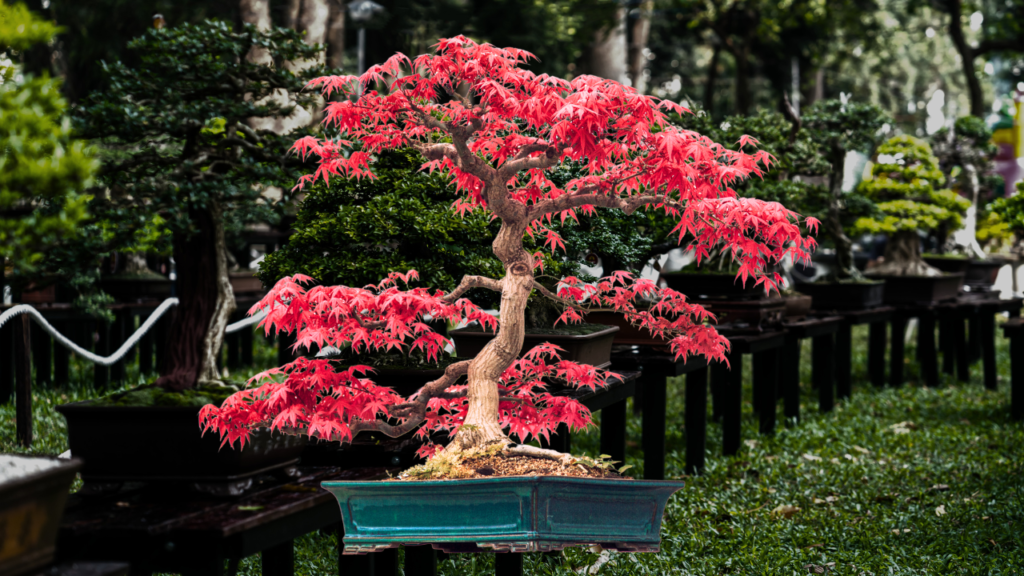Maple trees, with their vibrant foliage and intricate branch structures, are a captivating choice for bonsai. Their seasonal changes, from lush green in summer to fiery reds and oranges in autumn, make them a visual delight. Here’s an in-depth care guide to ensure your Maple bonsai remains healthy and vibrant:
| Maple Bonsai Quick Reference | |
|---|---|
| Attribute | Japanese Maple (Acer palmatum) |
| 🌾Plant Type | Deciduous tree |
| 📏Mature Size | Up to 49 feet (15 meters) in natural habitat |
| ☀️Sun Exposure | Thrives in sunny and airy locations. Requires indirect sunlight when temperatures rise to 85 °F (30 °C) or above. |
| 🍂Leaf Characteristics | Hand-shaped leaves with five pointed lobes (more lobes possible). Known for attractive autumn colors in shades of yellow, orange, and red. |
| ❄️Hardiness | Frost hardy but should be protected when temperatures drop below 15 °F (-10 °C). |
| 🌎Native Area | Japan, China, and Korea |
| 🌼Bloom Time | Reddish flowers appear in clusters in May to June. |
| 🍁Popular Varieties | Kiyohime, Kashima, Shishigashira, Arakawa, Deshojo, Seigen. |
1. Positioning and Light:
- Sunlight: Maples thrive in bright, indirect sunlight. Direct midday sun can scorch their leaves, so morning sunlight and afternoon shade are ideal.
- Outdoor Living: Maples are best kept outdoors to benefit from natural sunlight and seasonal changes. However, they should be protected from strong winds and extreme heat.
2. Watering:
- Frequency: Maples prefer consistently moist soil. Water when the top inch of soil feels dry to the touch. The frequency will vary with the season, requiring more water in summer and less in winter.
- Method: Use a gentle watering method to avoid soil erosion. Watering from above with a fine nozzle or a watering can is ideal. Ensure the pot has good drainage to prevent waterlogging.
3. Humidity:
- Maples appreciate higher humidity, especially during hot summers. Consider placing a humidity tray beneath the pot or misting the leaves occasionally. This is especially important during the leaf-growing phase in spring.
4. Soil and Fertilizing:
- Soil: A well-draining soil mix is essential. A blend of akadama, organic compost, and grit or pumice works well for Maples.
- Fertilizing: During the growing season (spring and summer), feed your Maple bonsai every two weeks with a balanced liquid fertilizer. In autumn, switch to a low-nitrogen fertilizer to prepare the tree for winter. Avoid fertilizing in winter.
5. Pruning and Shaping:
- Pruning: Regular pruning helps maintain the tree’s shape and promotes denser foliage. Spring is the best time for structural pruning, while light trimming can be done throughout the growing season.
- Wiring: Maples can be wired to shape their branches, but care should be taken as their branches are delicate. It’s best to wire in late winter when the tree is dormant and leafless.
6. Leaf Pruning:
- For denser foliage and smaller leaves, consider leaf pruning in early summer. This involves removing larger leaves, allowing smaller ones to grow in their place. This technique should be used judiciously and not on weak or young trees.
7. Repotting:
- Young Maple bonsai trees benefit from repotting every 2 years, while mature trees can be repotted every 3-4 years. Early spring, just before the buds break, is the ideal time.
- When repotting, gently trim the outer roots to encourage new root growth.
8. Pests and Diseases:
- Maples can be susceptible to aphids, scale insects, and root rot. Regular inspections and early interventions are key.
- For fungal issues, consider using a fungicide, especially during wet seasons.
9. Winter Care:
- While many Maple species are cold-hardy, they should be protected from extreme cold and frost. Consider placing them in a cold frame or unheated garage during harsh winter months.
10. Common Maple Bonsai Species:
- Japanese Maple (Acer palmatum): Known for its brilliant autumn colors.
- Trident Maple (Acer buergerianum): Features a robust root system and vibrant fall foliage.
- Amur Maple (Acer ginnala): Tolerant to colder climates and showcases bright red seeds.
Bonsai Care Essentials
Conclusion:
Maple bonsai trees are a testament to nature’s beauty and the artistry of bonsai cultivation. With their stunning seasonal transformations and intricate structures, they are a joy to nurture. With attentive care and a passion for the craft, your Maple bonsai will be a centerpiece of beauty and tranquility.
